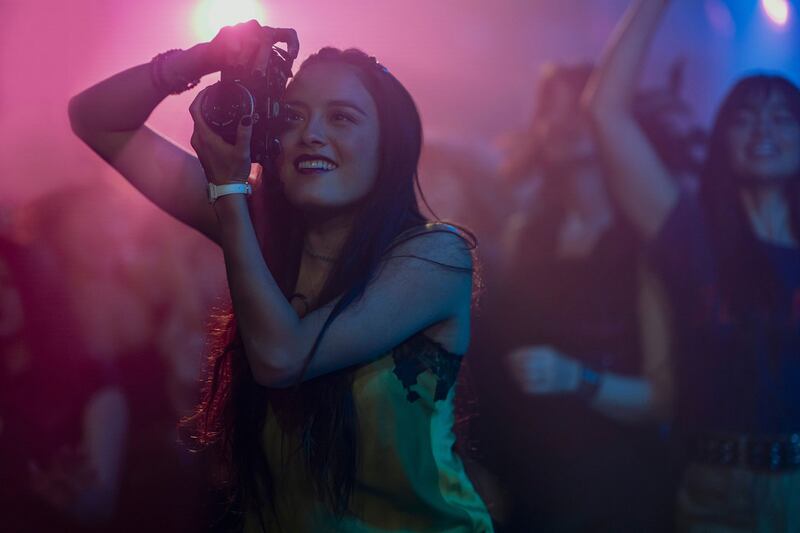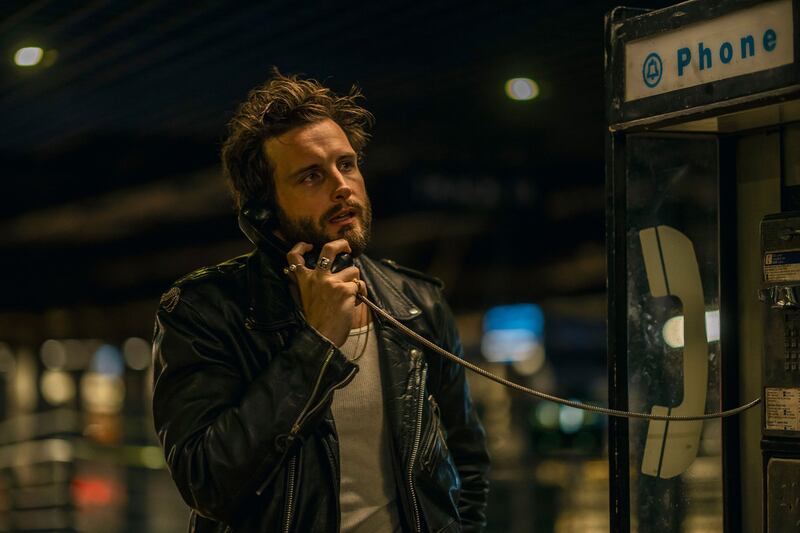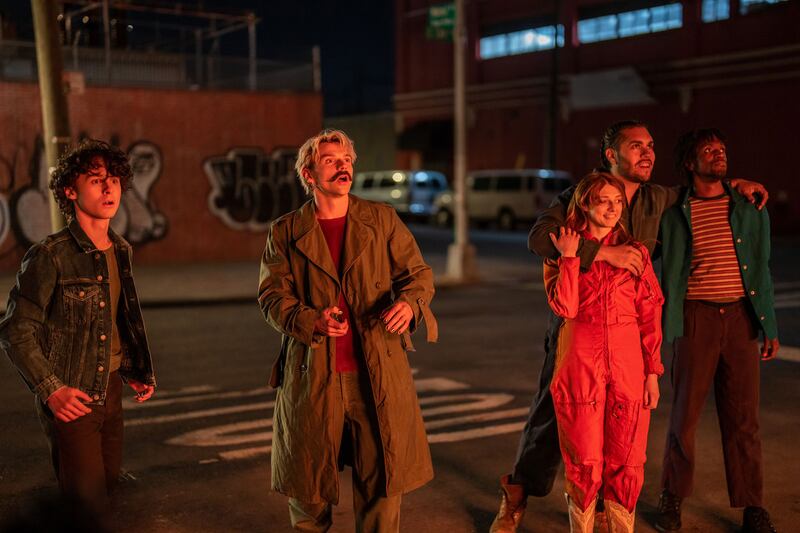Y2K is all the rage right now. Steve Madden’s chunky platform sandals have returned as the latest fad, and shows like Gossip Girl and How I Met Your Mother have been rebooted (to varying success). That trend continues with the new Apple TV+ drama series City on Fire, which sees several youngsters in the early 2000s solving a mystery in Central Park, while also setting fires in the post-9/11 New York landscape.
It helps, then, that Stephanie Savage and Josh Schwartz—who created iconic series from the early aughts such as the original Gossip Girl and The O.C.—teamed up to adapt Garth Risk Hallberg’s novel of the same name. Though the series feels timeless, it has that overdramatic teen drama flair, which is something that star Chase Sui Wonders found alluring.
“My box sets of The OC are like rags,” Wonders says on a Zoom with The Daily Beast’s Obsessed. “I would quote The OC to Josh, and he’d be like, ‘I don’t know what you’re referencing.’ I’d be like, ‘I’m quoting Seth Cohen! You literally wrote these words.’
“Obviously, I’m also a Gossip Girl fan, because who isn’t?” she adds. “Whoever isn’t a Gossip Girl fan is lying.”
City on Fire, which is set in late 2002 and early 2003, follows Sam (Wonders) as she joins forces with an up-and-coming band in New York. At first, she’s dedicated to their convoluted cause (to make a statement for artists around the city)—but when she learns their musical gig is just a front for their real act (setting violent fires around the city), Sam starts to grow wary of her commitment to them. Before she can make a move away from the group, however, Sam is shot in Central Park by an unknown figure and ends up in a coma.
Her pal/possible love interest Charlie (Wyatt Oleff) investigates her shooting, unraveling the machinations of the team of fire starters, including their ex-frontman Will’s (Nico Tortorella) involvement. Sam may have been sleeping with Will’s brother-in-law Keith (Ashley Zukerman), Charlie learns, which would put her in poor graces with the band and Keith’s battered wife, Regan (Jemima Kirke). Yes, there are a lot of storylines to keep up with.
“When I was 20 years old, I was filming a little CW show called The Beautiful Life, which was on at the same time that Gossip Girl was on. We were like, kind of folded into that crowd,” Tortorella says of that network’s millennial dramas. “I feel like Josh and Stephanie shaped my experience of New York and, through this show, are continuing to build my life in this city in such a beautiful way.”

Tortorella loved working with New York-set TV show legends like Schwartz, Savage, and Kirke, who had her big breakthrough starring as the free-spirited Jessa on Girls. Xavier Clyde did too; he plays Will’s high-strung boyfriend Mercer in the series and teams up with Regan to uncover Will’s shady past.
“The first thing I saw [Jemima] in actually wasn’t Girls. It was the most recent season of Sex Education,” Clyde says.
“So you saw her in something else before you saw her naked,” Tortorella interjects with a laugh, referencing Kirke’s frequent state of undress on Girls. “I’ve always thought we weirdly looked alike. When I found out that we were cast as brother and sister, I was like, ‘Shut up.’ There are certain things that are very similar—our styles of performance. We both bring this manic energy to the characters that we play.”
Wonders is also on the rise, with a few high-profile New York roles as of late. City on Fire is premiering nearly back-to-back with Peacock’s Bupkis, the comedy series that stars Pete Davidson as Pete Davidson. The two series are very different (one takes place primarily in Manhattan, the other in Staten Island—can you guess which is which?), but both debuting at the same time has added to Wonders’ star power.
“My whole family just binged Bupkis, and they’re so excited for City on Fire,” Wonders says. “They couldn’t be any more different, which is why it’s so funny. It’s two different muscles—Bupkis was a bunch of super-talented comedians going off, improvising. City on Fire is this very airtight, super-incredible TV show.”
There’s something else special about City on Fire, Wonders says: Ittakes place two decades ago, when iPhones weren’t available for making plans, finding new restaurants, or figuring out which event to crash on a Friday night.
“I wish I was going out and socializing [back] when I could just show up to a club and see if maybe some of my friends were there—but I didn’t have the pressure of starting the group chat, or ‘What am I posting on my story?’” Wonders says. “[There’s] all this stupid stuff that takes up so much of our bandwidth that you didn’t have to think about. It was much freer. You didn’t take things personally. Everyone’s just hanging out, looking for a good time.”

The lo-fi tech helped make things far more dramatic, Wonders says. No one is recording the fires and throwing it on their Instagram story—instead, Sam grabs shots via a point-and-shoot film camera, leaving the negatives behind for Charlie to piece together later.
Tortorella agrees that, from a story standpoint, City on Fire benefits from the lack of modern, convenient tech. “I feel like in so many other shows, the phone is like a secondary character to the script,” they say. “I was having this conversation with my therapist, when we started shooting the show. He was like, ‘In so many ways, New York City was the internet before the internet. It’s where everyone came to find themselves and whatever they were looking for.’”
City on Fire restored New York to its early 2000s state. Payphones replaced those new charging phone stations that New York now has scattered around the city (which themselves replaced payphones); cameras replaced iPhones. As for the costumes, however, the cast and crew had to ask themselves: How does one replicate early-aughts fashion without it simply looking like the characters have just hopped on today’s Y2K trend?
“Y2K [fashion] can get super-costumey super-fast,” Wonders says. “We were really deliberate about picking pieces that actually felt lived-in—a lot of vintage stuff. There are so many ugly trends from the early 2000s. We stayed away from the layered, lacy tanks. That Penny Lane coat with the fur [that Sam wears], that felt like a must. We built the wardrobe around that coat, because it was so cool.”
Most of the characters have perfectly styled wardrobes—Sam is the cool youngster, Will the washed-up rockstar, Regan a preppy Upper East Side mom—but Charlie goes through a big lifestyle transition over the course of the series. When we meet the high schooler, he’s a bit of a dweeb. But after hanging out with Sam and her band friends, Charlie takes on a whole new persona.
“Everyone has such a distinct and unique look who jibed with who they are as a person, not just as their character,” Oleff says. “My thing about Charlie was seeing how the other characters in the show influenced his clothing. He starts out in very boring [clothes]—then meets Sam and starts to dress cooler. [He] wears his Lou Reed shirt, his Richard Hell shirt.”
Though the original novel is set in the 1970s, the cast agrees that the shift to late 2002/early 2003 felt right for a show releasing in today’s post-pandemic landscape. In the series, the characters are grappling with the massive loss of 9/11, trying to figure out how to both move on and come together to solve the mystery of Sam’s attempted murder.

“The constant themes that run throughout the show—it’s the city coming out of a turbulent time and having those same feelings of grief, trauma,” Clyde says. “Where do you go from there? Where do you go after a monumental thing changes the very fabric of what this city and its identity is?”
At the beginning of the season, we learn that Charlie’s father was a firefighter who died in the aftermath of 9/11 and see the character trying to find a new purpose, in the wake of his dad’s passing. The show seeks to answer the question of what recovery looks like, especially while living in a city still trying to get its footing back after such a huge disaster. As we roll past the three-year anniversary of the COVID-19 pandemic’s outbreak in New York, Oleff hopes folks from the city (and elsewhere) can resonate with the themes of City on Fire.
“It feels like the appropriate time to look back retrospectively and sort of objectively on the early 2000s,” Oleff says. “It feels almost like a little bit of a cycle is happening. We’re in a post-something-big-happening state. We’re all a little confused. We’re all coming out of it and trying to find solidarity in one another.”






